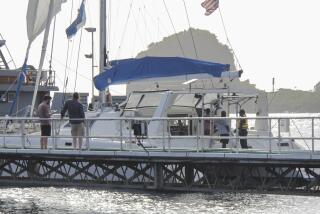Boat Hijacked Out of Cuba Returns Home
- Share via
MIAMI — Cuban hijackers who on Wednesday commandeered a ferry in Havana’s harbor, sailed it until the fuel ran out and then threatened to throw passengers overboard unless they were given another boat finally returned to Cuba early today, authorities said.
The ferry -- reportedly carrying 15 to 20 people -- had been adrift in choppy international waters between Cuba and Florida, about 40 miles from Key West. The FBI had sent a hostage negotiation team by helicopter to link up with one of two cutters dispatched by the U.S. Coast Guard.
It was not clear early this morning whether the hijackers had surrendered.
The 50-foot ferry also was shadowed by two ships from the Cuban Frontier Guards, according to accounts by Cuba’s state-run media. The hijackers had claimed by radio to be armed with three pistols and a knife.
The takeover occurred one day after a Cuban man carrying fake hand grenades hijacked an airliner to Key West and the Cuban leadership renewed its accusations that U.S. policy was directly to blame. Would-be hijackers in the communist-ruled island are encouraged by the “tolerance, resources, benefits, privileges, help and propaganda” that foes of the Cuban revolution are given by Washington, the Cuban Communist Party daily Granma charged.
In an unusual move Wednesday night, the top U.S. diplomat in Havana warned Cubans that anyone using hijackings to reach the United States would be prosecuted, jailed and then ejected from the country.
The tough comments by James Cason, chief of the U.S. Interests Section, in a televised message on communist-run television underscored U.S. alarm that recent hijackings could spur a migration crisis.
The ferry, capable of carrying 100 people, belongs to a small flotilla that shuttles Cubans from one side of Havana Bay to the other. According to the account of events posted on Granma’s Web site, the launch was hijacked by an unidentified number of people about 1:30 a.m. and headed north for Florida until running out of fuel.
The hijackers contacted Cuban authorities by radio, claimed to have 50 people on board, and warned they would start throwing them into the sea unless they were given another boat.
Cuban officials initially had been mostly tight-lipped about the incident but had issued a statement about midday, saying: “The hijacked vessel is adrift 30 miles from our coastline, in international waters, and the hijackers demand fuel to continue their trip.”
Rough seas were reported, with swells reaching eight feet.
Judy Orihuela, the FBI’s spokeswoman in Miami, said the Cuban border patrol told U.S. authorities that the flat-bottomed vessel was in the hands of two armed hijackers. Cuban officials reported that there were 15 to 20 people on the ferry, Orihuela said. There was no immediate explanation for why that number differed from the one used in Cuban media accounts.
In Havana, security reportedly was beefed up at ferry stations, with police frisking passengers and checking identity documents.
In 1994, as Cuba’s state-managed economy veered toward crisis, a seaborne exodus toward American shores began in earnest. With the apparent blessing of President Fidel Castro, more than 40,000 Cubans -- many risking their lives on homemade rafts or in fragile boats -- set off for the United States.
Under a subsequent bilateral agreement, Castro agreed to turn off the flow of rafters in exchange for an increase in the number of visas for Cubans who applied to immigrate to the United States legally.
Max Castro, a senior research associate at the North-South Center of the University of Miami, said the Cuban economy is again in dire trouble, with tourism greatly depressed since the Sept. 11 terrorist attacks. But he said it was too early to say whether a spate of hijackings might be the harbinger of another large-scale movement of Cubans to the United States.
In Key West, federal prosecutors said Adermis Wilson Gonzalez, the man accused of diverting a Cubana Airlines propeller-driven airliner to Florida on Tuesday, will be charged with hijacking, an offense that carries a sentence of 20 years to life in prison. He allegedly used two fake grenades to hijack the plane, which U.S. officials said was also carrying his wife and 3-year-old son.
On March 19, a group of six Cuban men hijacked a commercial flight to Key West. A federal magistrate granted them bail, a decision that infuriated the Cuban government. But U.S. prosecutors appealed the decision, and the six men remain in jail.
*
Associated Press contributed to this report.
More to Read
Sign up for Essential California
The most important California stories and recommendations in your inbox every morning.
You may occasionally receive promotional content from the Los Angeles Times.













